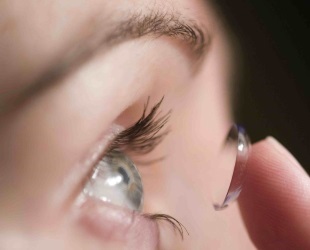
In recent years, contact lenses have gained immense popularity among people with visual impairments.
First of all, this is due to their convenience, because contact lenses do not interfere with an active lifestyle: they allow you to play sports, they can not be lost or broken.
But do not forget that the contact lens for the eye is a foreign body, which means that due to its constant presence, various problems can arise.
Most often inflammatory diseases and allergic reactions develop. To avoid this, you must follow the rules of wearing contact lenses and regularly take care of them.
- 1. Types of contact lenses. Admissible time of wearing them
- 2. Consequences of exceeding the time of wearing contact lenses
- 3. How to prolong the service life of contact lenses? Care tips
- 4. Conclusion
- 5. Video in the subject
Types of contact lenses. Admissible wearing time
There are many varieties of contact lenses. It depends on what kind of lenses you use, the time of their wearing depends.
In terms of continuous wear, contact lenses can be divided into three groups:
- Contact lenses day wear .Such lenses must be removed at night. Maximum continuous wearing time is 14 hours.
- Contact lenses long wearing .This kind of contact lenses can not be removed within a week.
- Contact Lenses Continuous Wear .They are allowed not to be removed within one month.
Despite the fact that manufacturers allow the continuous wearing of some types of contact lenses, it is better not to abuse it and not be lazy to take off the lens before going to bed.
The following types of contact lenses are distinguished by their operational life:
| Description | Description |
| Classic models | Their average service life is from 6 months to 9 months. They are good for their low cost, but they require daily and expensive care. It consists in the constant use of special solutions and tablets for purification from bacteria. In addition, over time, the material from which such lenses are made, changes its physical properties, and harmful protein deposits form on it. They cause bacterial infections of the eyes. Often one lens becomes unusable before the second |
| Quarterly models of the | Such lenses are 3 months old. On the market they are rare and hardly used |
| Models of planned replacement | They are designed to be worn for 30 days. Produced from both hydrogel and silicone hydrogel. Do not require cleaning with expensive enzyme tablets - they just need a simple disinfectant solution |
| Models of the weekly replacement | Implies wearing no more than 7 days. In extreme cases, it is possible to extend the service life to 14 years. This kind of lens is made of materials containing a large amount of moisture, so they do not require any special cleaning. They rarely cause irritation of the mucous membrane of the eyes and other unpleasant symptoms. |
| One-day | As it becomes clear from the name, the life of these lenses is only one day, after which they are disposed of. Such lenses are quite high in value, but with certainty it can be said that they are worth the money spent. They never cause inflammatory eye diseases, as every day you put on sterile lenses that have not been treated with any chemicals. Also, thanks to modern materials, one-day lenses do not have a negative effect on the visual acuity of |
Separately it is worth mentioning colored contact lenses, as they are becoming more popular. Someone with their help wants to change the color of the eyes to a brighter and more attractive, and someone puts them on to attract attention at a disco or a theme party.
If the lens is removed incorrectly, the life of the lens will be much less than the one declared by the manufacturer. We look at how to do it correctly:
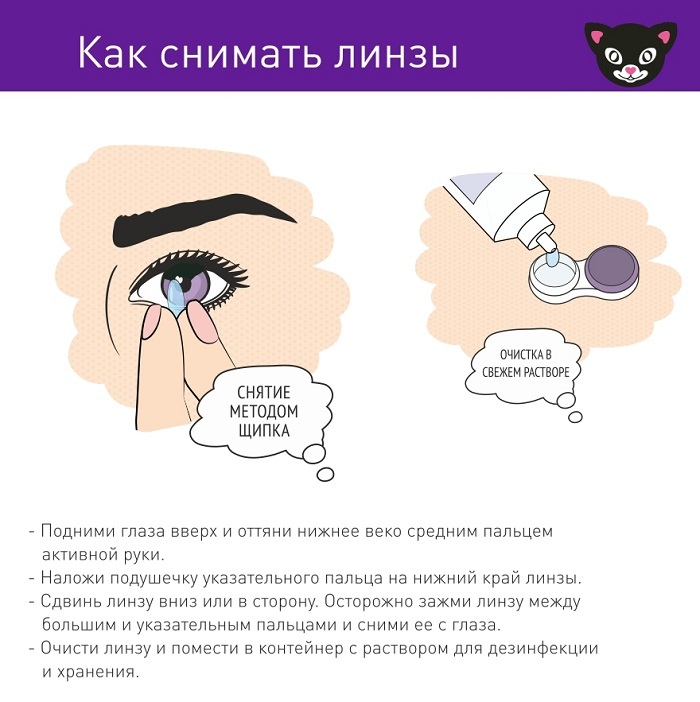
Colored contact lenses have two important features:
- They are made of very soft material, which means that their wearing leads to insufficient intake of oxygen to the corneal tissues.
- Many of them are opaque. This leads to a distortion of color perception and over time can cause serious visual impairment.
Based on this, it is believed that wearing color lenses without removing, you can not more than 4 hours .If suddenly you feel a decrease in visual acuity, burning and rubbing in your eyes, you need to remove the lens immediately.
In no event should you leave your lenses at night, as this can lead to hypoxia of the corneal tissues. Before use, always carefully study the instructions for using colored contact lenses, since they may have certain nuances in care.
Eyes should gradually get used to colored lenses, so they should be worn starting from half an hour a day, slowly increasing the time.
Consequences of exceeding the time of wearing contact lenses
The terms of wearing indicated on the packaging by the manufacturer are not just invented. There are numerous studies that help determine the safe time of wearing, so do not neglect the instructions in the instructions.
The following picture will help to avoid mistakes when dressing lenses:
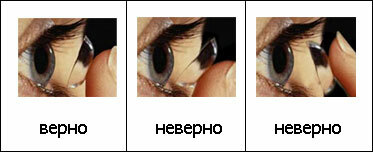
Due to constant contact with the eye mucosa, the material from which contact lenses are made wears out and changes its physical properties.
Even the most expensive and high-quality lenses become uneven, porous and cloudy over time.
These changes in the surface structure contribute to: the
- accumulation of body fat;
- accumulation of protein deposits;
- to the constant falling and the settling of dust, dirt and other particles falling from the environment;
- reproduction of pathogens.
Over time, harmful bacteria and dirt particles penetrate the lens so deeply that no cleaning systems can cope with them.
If the contact lenses provided by the manufacturer are exceeded, this can lead to serious consequences. Here are the main ones:
- Deficiency of oxygen in corneal tissues. Chronic hypoxia provokes excessive vascular growth and corneal edema. These pathological changes eventually cause irreversible visual impairment.
- Allergic reactions. The most common papillary conjunctivitis. It is manifested by burning, itching, redness and photophobia.
- Non-infectious keratitis .In this complication, blood cells are deposited in the tissues of the cornea. This causes blurred vision and the appearance of so-called "flies".Keratitis occurs because of an excessive immune response of the body to foreign proteins and fats on the surface of the lens.
- E rosii of the outer shells of the eye. They arise due to excessive friction and sloppy lens removal. The patient feels a burning sensation, a pain, a pain in the eyes. His eyesight deteriorates and tear fluid is excessively released.
- Red eye syndrome. It is manifested by increased lacrimation, a sensation of sand in the eye and pronounced reddening.
- Deformation of the cornea. Prolonged use of soft lenses without sufficient interruptions can provoke a sudden change in the shape of the cornea as a result of mechanical stress. Complication is manifested by a sharp decrease in vision.
- Bacterial and viral infections. Blepharitis, inflammation of the optic nerve, iridocyclitis, panophthalmitis, dacryocystitis are most common.
These complications significantly impair the quality of life and require long-term treatment, so it is much easier to prevent them if you follow the rules of wearing contact lenses.
How to extend the life of contact lenses? Care tips
To ensure that the contact lenses have served you for a specified period of time and at the same time remain completely safe for the eyes, it is necessary to look after them properly.
Here are the basic rules for contact lenses:
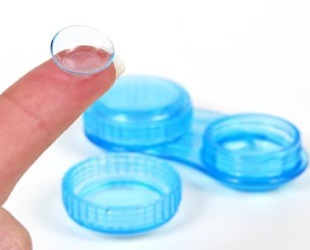
- Before any contact with lenses, you should carefully wash your hands with soap with antibacterial properties and dry them with a clean towel.
- The storage container should be regularly filled with a clean disinfectant solution that has not expired.
- Contact lenses take the form of the eyeball, which they regularly wear, so do not confuse them with each other.
- The lens must be cleaned immediately after removal.
- The storage container also has a shelf life - it needs to be changed every 30 days.
- It is not necessary to save on disinfectant solutions and enzyme tablets, since the degree of purification depends on their quality. In addition, the more quality the means, the more sparing they affect the material from which the lenses are made.
- It is recommended to keep the lenses in the solution at the prescribed time( not less than 6 hours).
- The contact of lenses with moisture should be avoided to the maximum( especially for chlorinated and tap water).
- Tobacco smoke reduces the life of contact lenses, so you need to reduce the number of cigarettes you smoke or completely abandon this bad habit.
It is very important to wear contact lenses the right way. The following picture will help to avoid mistakes:
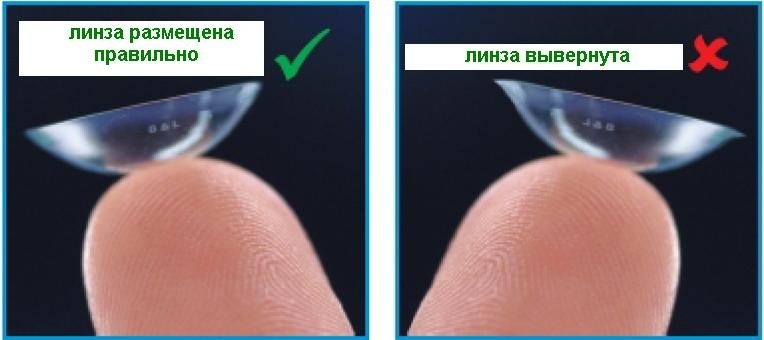
Conclusion
- Contact lenses are a modern and convenient method of vision correction.
- All contact lenses have a certain lifespan and continuous wear.
- You can find out the period of wear by reading the instructions for use.
- Exceeding the allowable period of socks can lead to the development of serious complications from the organs of vision.
- To ensure that the lenses last as long as possible, it is necessary to properly use and care for them.
Video by
This video might be interested in you:
